The Best Bass Guitar Strings
We may also earn commissions on purchases from other retail websites.
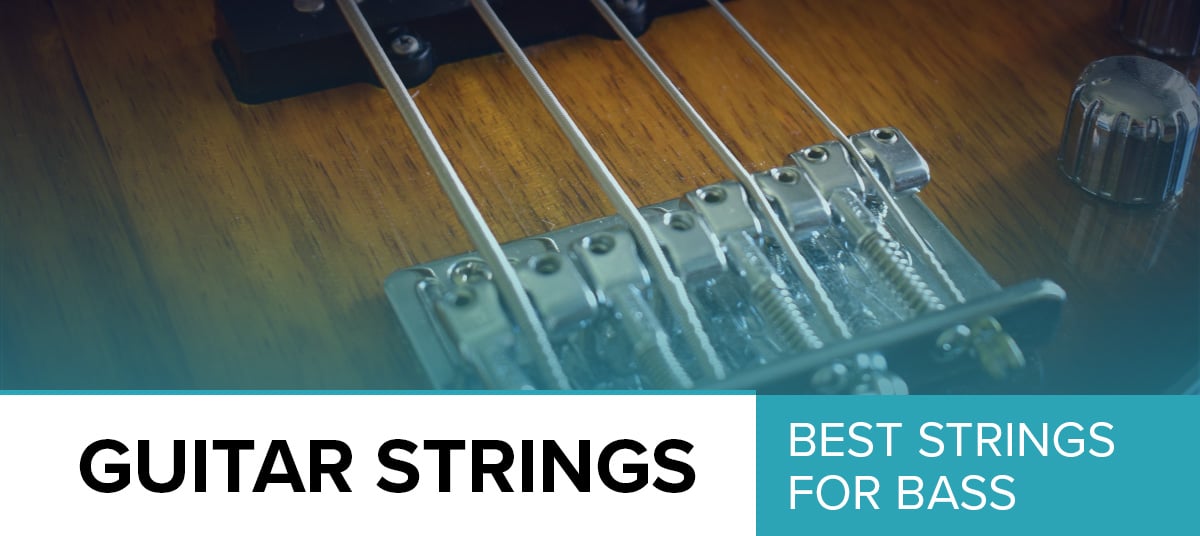
Last Updated Jul-31-2018.
While wholesale changes weren’t needed in our latest refresh, we have tweaked a few things to make navigating this article a little easier, as well as updating the content to offer more answers to your bass string questions!
If you’re looking for a new set of strings for your bass, you’ve come to the right place! We’ve tried and tested some of the best-selling string sets on the market today – from GHS to Ernie Ball – and have shared our opinions in the following article.
So what is the best bass string? As you may have read in our guide to the best guitar strings, the word ‘best’ is hugely objective when it comes to strings, and my best may not necessarily be yours.If you’re a beginner you’ll want some recommendations. If you’ve been playing bass for a while, chances are you may have found a favorite brand or what you feel is the best string for you, but it’s always worth testing others – or at least reading about them – to see if a different brand could suit your style better.
Keep reading for a guide on how to find the right strings for you and some brand reviews, just underneath our chart highlighting five popular bass string sets on sale today.
5 Recommended Bass Guitar Strings:
| Image | Guitar Strings / Rating | Summary | Check Price |
|---|---|---|---|
+ -  | D'Addario EXL160 Nickel Wound Total of 4.80/5 | D'Addario's best-selling long-scale heavy gauge (.050-.105) strings. | |
+ -  | DR Strings Hi-Beam Total of 4.70/5 | Popular roundwound stainless steel bass strings with a medium gauge (.045-.105). | |
+ -  | Ernie Ball Super Slinky Nickel Total of 4.00/5 | Top-selling nickel bass strings with a medium gauge (.045-.100) and versatile sound. | |
+ -  | GHS Bass Boomers Total of 4.00/5 | Power and sustain – one of the most popular bass strings in the world. | |
+ -  | RotoSound Swing Bass 66 Total of 4.70/5 | Popular bass strings, with a medium gauge (.045-.105) and bright tone. |
The five sets of strings in the chart above barely scratches the surface when it comes to the choice on the market today, but they give you an idea of what’s out there to complement your favorite bass guitar. Make sure to keep reading for a look at some of the major bass string brands, and what they can offer you.
D’Addario
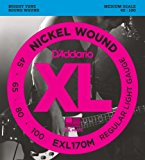 As one of the world’s oldest and largest guitar string manufacturers, it’s no surprise that D’Addario make bass strings too – strings that come in a wide range of scales, gauges, materials, and construction methods. Their high-quality strings are proudly made in America and used by bassists everywhere, from beginners to seasoned pros. It’s their popular XL Nickel Wound strings that are known as ‘The Player's Choice’ among bass players of all levels and styles, with a distinctive bright and versatile tone.
As one of the world’s oldest and largest guitar string manufacturers, it’s no surprise that D’Addario make bass strings too – strings that come in a wide range of scales, gauges, materials, and construction methods. Their high-quality strings are proudly made in America and used by bassists everywhere, from beginners to seasoned pros. It’s their popular XL Nickel Wound strings that are known as ‘The Player's Choice’ among bass players of all levels and styles, with a distinctive bright and versatile tone.
If it’s a smoother, mellow tone you are looking for, their XL Nylon Tape Wound strings offer a deep, warm tone that’s very effective for jazz and orchestral bass players. At the other end of the spectrum, rock and metal bassists would be well suited with D’Addario’s modern, ultra-strong NYXL strings, which provide deep bass tones and great sustain, and come in a range of gauges. D’Addario also offer a micro-fine EXP coating on some string sets, resulting in a longer life with all the feel of a regular string.
DR Strings
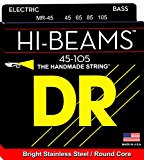 Founded in 1989, the New Jersey-based DR Strings are renown for their bass strings, which are still made by hand. They have a huge range of string sets, each with their own benefits and characteristics, including Lo-Riders, Sunbeams, and Fat-Beams. The first set you check out should be their classic best-selling medium-gauge (.045-.105) Hi-Beams, which are roundwound stainless steel strings, excellent for beginners and pros alike, offering a bright but balanced sound.
Founded in 1989, the New Jersey-based DR Strings are renown for their bass strings, which are still made by hand. They have a huge range of string sets, each with their own benefits and characteristics, including Lo-Riders, Sunbeams, and Fat-Beams. The first set you check out should be their classic best-selling medium-gauge (.045-.105) Hi-Beams, which are roundwound stainless steel strings, excellent for beginners and pros alike, offering a bright but balanced sound.
Elsewhere on the list, their popular Pure Blues use a very responsive Quantum Nickel, which mixes the brightness and accuracy of steel with the warm punch of nickel, resulting in a very versatile string. For heavy rock and metal players, their dedicated Drop-Down Tuning DDT-55 strings are a superb tool in the arsenal, with a heavy gauge (.055-.115) that offers clarity and incredible tuning stability. DR are used by legendary bassists such as Sting (who uses Nickel Lo-Riders), as well as Fieldy from Korn, Geezer Butler of Black Sabbath, and Ian Hill from Judas Priest – so you know you’re in good hands!
Ernie Ball
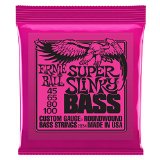 This famous Californian string brand have been in business since 1962 and are still producing awesome strings for basses, with top selling artists using them on stage and for recording – including Blink 182’s Mark Hoppus, Timothy B. Schmit of The Eagles, Tool bassist Justin Chancellor, and Maroon 5's Mickey Madden. Just like their guitar strings, Ernie Ball’s range of bass strings is varied, with something to suit everyone, whatever scale, gauge, material or style of bass you play. Their best-selling Super Slinky Nickel strings are the go-to bass string for many players, as they are affordable and offer a bright, balanced tone in many gauges, from extra slinky (.040-.095) to power slinky (.055-.110).
This famous Californian string brand have been in business since 1962 and are still producing awesome strings for basses, with top selling artists using them on stage and for recording – including Blink 182’s Mark Hoppus, Timothy B. Schmit of The Eagles, Tool bassist Justin Chancellor, and Maroon 5's Mickey Madden. Just like their guitar strings, Ernie Ball’s range of bass strings is varied, with something to suit everyone, whatever scale, gauge, material or style of bass you play. Their best-selling Super Slinky Nickel strings are the go-to bass string for many players, as they are affordable and offer a bright, balanced tone in many gauges, from extra slinky (.040-.095) to power slinky (.055-.110).
For a more specialist string, their chrome-plated steel Flatwound Set are a good choice, and offer a warm, mellow tone with a silky feel and good durability. Ernie Ball also offer hybrid strings for maximum versatility, slinky cobalt strings with a huge output, and long-lasting coated bass strings – not to mention strings for five and six string basses, as well as acoustic basses!
GHS
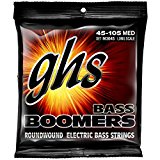 The long-running string brand GHS was established in Michigan in 1964, and still produces awesome bass strings today, with a huge range that’s hard to beat. Their famous Bass Boomers are one of the most popular bass strings on the market today, coming in many different scale lengths and gauges, as well as five and six string sets. These Boomers are the classic ‘power string’, made with roundwound nickel-plated steel on a strengthened core, offering excellent volume and sustain. GHS have an endless roster of professional, top-selling artists and bands that use their bass strings, including Andrew W.K., the Goo Goo Dolls, Rancid, Soundgarden, and, one of the most famous bassists of all time, Flea, of the Red Hot Chili Peppers.
The long-running string brand GHS was established in Michigan in 1964, and still produces awesome bass strings today, with a huge range that’s hard to beat. Their famous Bass Boomers are one of the most popular bass strings on the market today, coming in many different scale lengths and gauges, as well as five and six string sets. These Boomers are the classic ‘power string’, made with roundwound nickel-plated steel on a strengthened core, offering excellent volume and sustain. GHS have an endless roster of professional, top-selling artists and bands that use their bass strings, including Andrew W.K., the Goo Goo Dolls, Rancid, Soundgarden, and, one of the most famous bassists of all time, Flea, of the Red Hot Chili Peppers.
In fact, Flea – known for his funk-punk lead bass playing and hard-hitting bottom end – has his own signature set of GHS strings: the M3045F Flea Signature Bass Boomers. Other sets in the GHS bass line include Brite Flats, LTD Edition Infinity Steels, and their hugely affordable Bassics – perfect for beginners.
RotoSound
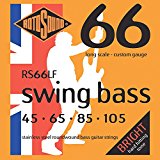 RotoSound are a very famous British string brand, born in England in 1958. They have a long history of producing quality bass strings used by iconic players and classic bands, including Thin Lizzy, The Who, Queen, Duran Duran, Slade, Fun Lovin’ Criminals, and Weezer. RotoSound have the reputation for pioneering new concepts, and hold the accolade of being the first string company to produce roundwound strings, with their Swing Bass 66 being one of the most popular roundwound bass strings of all time, and available on the market today in all kinds of gauge and scale length.
RotoSound are a very famous British string brand, born in England in 1958. They have a long history of producing quality bass strings used by iconic players and classic bands, including Thin Lizzy, The Who, Queen, Duran Duran, Slade, Fun Lovin’ Criminals, and Weezer. RotoSound have the reputation for pioneering new concepts, and hold the accolade of being the first string company to produce roundwound strings, with their Swing Bass 66 being one of the most popular roundwound bass strings of all time, and available on the market today in all kinds of gauge and scale length.
Another great string series offered by RotoSound that gains a lot of praise is their Jazz Bass 77, which offers a warm and fat tone, perfect for jazz. For beginners looking for a set that sounds good but doesn’t cost too much, the RotoBass range of strings are highly recommended. Finally, it’s worth noting that legendary bassist Billy Sheehan and Iron Maiden’s Steve Harris both have their own stand-out RotoSound signature string sets!
This small selection are by no means the only brands out there – there’s Dunlop, Fender, Elixir, Cleartone, Dean Markley, and many more. But these five are the most popular, and produce some awesome strings, well worth your attention.
Guide to Buying The Right Bass Strings For You
If you’ve recently started playing bass you may notice that bass strings are a little more expensive than a normal set of strings for electric guitars. This is because bass guitar strings are heavier and have bigger gauges, therefore requiring more materials to produce.
Materials
What materials are used to make electric bass strings? It’s a good question, because different metals make a different sound and therefore suit different styles of music. For example, the most popular choice for modern bassists is nickel-plated steel, which offers a well-balanced tone, somewhere between warm and bright, making it an excellent all-rounder for everything from rock to blues.
Another fashionable bass string material is pure nickel, which gives the strings a warmer, ‘broken-in’ tone and is therefore superb for vintage sounds, like 50’s and 60’s classic rock and pop, as well as all sorts of country music. At the other end of the spectrum, stainless steel strings – which are very effective for slapping and popping techniques – offer a very bright sound, so are good for rock, funk and metal players, as well as jazz bassists. You can also find other metals such as chrome, titanium, cobalt, and copper-plated steel, which all have different tonal characteristics.
Gauges
Just like those on a guitar, bass strings vary in gauge and the thickness you choose will affect how your bass performs.
A set of medium strings, which would have a typical gauge of around .045-.105, are a good place to begin and are the favorite choice for many bassists, as these allow easy playing with enough versatility in tone. Beginners will benefit from sticking to a medium gauge string, such as Ernie Ball’s Super Slinky Bass Strings.
However, more experienced bassists should always indulge in a little experimentation. For example, if playing lead bass – with lots of walking bass lines and slapping – is your style, a lighter gauged set of strings (around .040-.100) would be a good call. If you are a heavy rock or metal bassist, heavier strings will be beneficial as they cope better with low tunings and aggressive playing, and offer a thicker tone – a gauge of around .050-.110 is what you are looking for.
Remember, if you are playing with a five or six string bass, you’ll be presented with even more gauges. You may see an extra heavy fifth string with a beefy gauge of .115, or a very light sixth string with a .028 thickness.
Windings
When looking at the windings of the bass string, the most popular style among bassists – especially rock and funk players – are roundwound strings. Another common method, that’s particularly hot with jazz bassists and those seeking mellow, vintage tones, are flatwound strings. You’ll find more information on the various string windings and cores, and what they mean, in our article on the best guitar strings.
Scale Lenghts
Finally, although it may seem obvious, it’s worth pointing out that bass strings come in sets with specific scale lengths – long, medium, short, and so on. To find the scale length of your bass, measure the length between the nut and bridge saddles, or search for it on the bass manufacturer’s website, handbook, or box that came with the model. Although scale lengths change, typically you’ll see short (32” and below), medium (32” to 24”), and long (34” to 36”) lengths listed on string packs. If in doubt, ask your local guitar pro.
What are the Best Bass Strings for Beginners?
While all brands promise different things for different bassists, there isn’t one that stands out as ‘the best’ when it comes to bass strings for beginners. However, the brands we highlight in this article are worth checking out if you are buying your first pack of strings.
In general, we recommend going for a medium gauge string, as this will suit beginner fingers nicely. Bass strings can be much higher in price than a set of guitar strings, so looking for something affordable is also a good idea for beginners. Until you get to grips with the small variations in tone and feel, buying an overly expensive pack of strings is unnecessary when you are just starting out.
When is it Time to Change Bass Strings?
Sadly, bass strings don’t last forever and will need changing – but how often should you do it? It depends on how often you play and the conditions in which you store the bass, but a good rule of thumb is every 100 hours or three months (whichever comes first).
Oil, dirt and sweat build up on bass strings over time and can affect the tone and feel of the instrument. So, if your bass begins to sound a little flat or lifeless, or if the strings feel gritty or unpleasant to slide around, you will probably benefit from changing the strings.
What Does ‘Warm’ and ‘Bright’ Mean When Talking About Tone?
Tonal descriptions such as ‘warm’ and ‘bright’ are completely subjective, so finding a definitive answer (especially put into words) is tricky. However, when talking about bright or warm bass tones, most bassists agree that these terms share some characteristics.
When it comes to a bright tone, bassists are referring to a sparkly, trebly, metallic, jangly, vibrant sound – one which works well for slapping and popping, as well as metal, rock and funk players. Stainless steel bass strings are a good choice for bright tones.
As for warmth, this is referring to a smooth, creamy, easy-going sound, which is associated with vintage and country music, as well as rock and pop. Nickel strings can help deliver this delightful warm tone.
The Final Word
Firstly, if you are changing your strings for the first time, make sure to check out the video below, which gives a good overview on how to change your bass strings – not always the easiest process, especially for a beginner.
When shopping around for a set of bass strings, it’s best to try out a few different brands, gauges and materials to find something you like. This doesn’t have to be all at once – you may try a few sets over a six month period, depending on your budget and how often you play.
Only when you know what is out there will you find the perfect string for you – something that will keep you happy for years to come. Good luck with your string shopping!






Brian Wood says
Really helpful article but there’s an obvious typo. I’ve had my Precision for 36 years and today for the first time I’ve measured its scale length…..it’s long. In the article you have the medium scale length as 32″ to 24″. Thanks again for some great advice.
Alex Loudoun says
An interesting article and very enjoyable. I’ve been playing guitar for 51 years now and recently took up bass so looking for the right information to help me along although I know a bit about strings there’s always something new to learn. Obviously heavier gauge strings should also give you a warmer tone
Link says
Cool. 6 string playing since 6 in ’59. Wow, just realized that. Not great, just enjoy. Coerced into starting a jam session a few years ago at a local club. No bassists would show. I aquired “more” equipment, and muddled along till a now passed away bluesman, and once frequent flyer in Austin became my close friend. Initially because I could drive and he was blind. Rick could play anything on anything. Occasionally I would foolishly argue notes with him. My mentor now laughing at my bumbling looked down and steered me to you to replace the antique roundwounds on my LG-3L. Thank you for advising an old beginer.